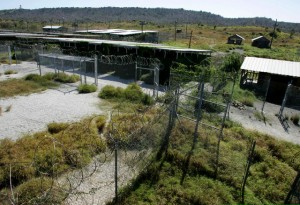What is in a Name?
National Dialogue and Traveling Exhibit

Camp X-Ray months after prisoners were moved to Camp Delta in April 2002. Image by © Joe Skipper/Reuters/Corbis
The language of post 9-11 Guantánamo is intrinsically messy. Terminology is designed to be complicated, interwoven with the realities of legality and circumstances. This couldn’t be truer when referring to the group of 300 men, detained at Camp X-Ray between January to March 2002.
Camp X-Ray was originally built in 1994 as a detention facility for migrants and refugees who were deemed criminals or had failed the screening process. The camp was set apart from the rest of the naval station, both by its location on the southeastern side of the base and its name––set at the end of the alphabet, unlike the other bases on the island. Some explain that its name reinforces its association as a place set apart for criminals, far from Camp Alpha or Camp Delta. Others assert that this name is solely based on its isolated location. Etymology aside, military officials chose this site as the detention facility for ‘enemy combatants’ who were transferred from Kandahar. Within three weeks, 120 hastily built mesh cage cells were constructed on the site, just in time for the first arrival of detainees on January 11, 2002.
While researching Camp X-Ray, I was struck by the paradigm of seemingly haphazard standards, in contrast to the very deliberate terms used to describe the inhabitants of the detention center. Terrorist, prisoner, detainee, or unlawful enemy combatant all have their own connotations, rooted in ideology. For instance, the definitions of detainee, someone who is captured during an armed conflict, and enemy combatant, an individual who is detained during an armed conflict, initially seem very similar. However, the legal implications reveal that they are quite different. Detainees, prisoners, or lawful enemy combatants are entitled to prisoner of war status under the Geneva Convention, the international agreement on humanitarian treatment. An unlawful enemy combatant, according to the Department of Defense in December of 2002, does not receive such protections.
All of these intricacies have been the subject of debate, especially in light of the conditions present at Camp X-Ray. As court cases close the legal loopholes surrounding the Geneva Conventions, the implications of these terms turns to public perception. Do such fungible terms, which can so concretely implicate a specific ideology, inform our opinion of those individuals held at Guantánamo? How does our terminology effect who remains at Guantánamo? Realistically, I believe it does. It is easy to separate our selves from these terms, to use terminology to paint ‘enemy’ onto a detainee and push them and the condition they are held far from our minds––to use terminology as a crutch to implicate human rights violations. I think an examination of our vocabulary is necessary, and allows us to continue the conversation of Guantánamo’s public memory.
Posted by Callie McCune – M.A. Candidate at Indiana University-Purdue University at Indianapolis.
Indiana University-Purdue University at Indianapolis is participating in the Guantánamo Public Memory Project‘s National Dialogue and Traveling Exhibit. Opening at NYU’s Kimmel Center for University Life Windows Gallery in December 2012 and traveling to 9 sites (and counting) across the country through at least 2014, the exhibit will explore GTMO’s history from US occupation in 1898 to today’s debates and visions for its future. The exhibit is being developed through a unique collaboration among a growing number of universities as a dialogue among their students, communities, and people with first-hand experience at GTMO.
